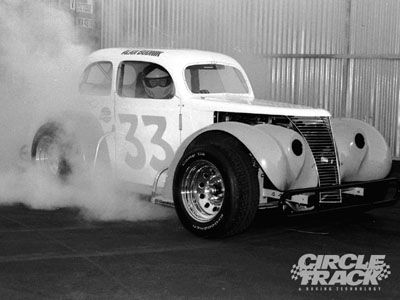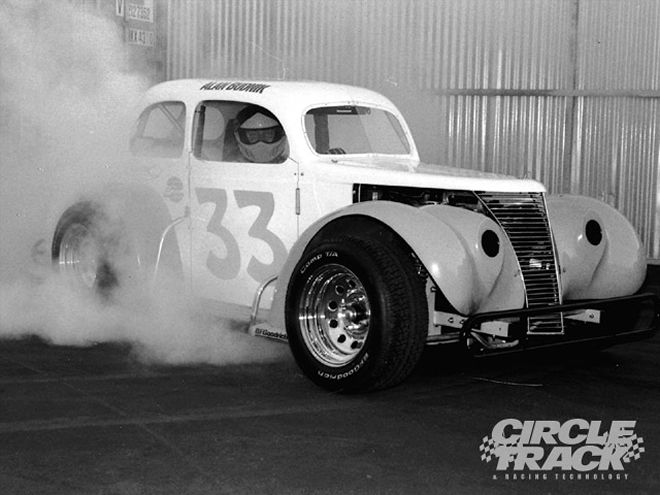
 Air, I need more air. You can almost hear the engine in a Legends car begging for more cool air. More air can be found by keeping the oil cooler small and down low in the engine compartment.
Air, I need more air. You can almost hear the engine in a Legends car begging for more cool air. More air can be found by keeping the oil cooler small and down low in the engine compartment.
Heat is the number-one killer of racing engines. It is especially deadly to an air-cooled Legends motor, but there are steps the racer can take to minimize the devastating effects of heat. In this article, we will look at changes that build horsepower and increase the longevity of the motor. In addition, we will suggest things the racer can do in the engine compartment to reduce power-robbing heat.
Everyone knows increasing horse-power increases heat. Legends drivers trying to add power can certainly attest to this. With the hard-compound BFGoodrich T/A tires, only so much grip is available. The answer to the age old question of whether to spend money on the engine or on getting a better handling car comes from the suspension side first for the Legends driver. With these lightweight cars, handling will win more races than horsepower. When a stock 115hp engine can spin the tires, any extra horsepower will go up in smoke off the right rear tire.
Most drivers believe their cars handle as well as everyone else's. When the race winner pulls them down the straightaway, they just know he has more power. It can't be that he's hooked up better coming off the turn. But if you're going to add power, do it wisely.
Building a Better Engine PackageThe Legends FJ 1200 Yamaha engine is a strong piece, if it doesn't get too hot. The rules do not allow many changes, but some things, if done right, will add longevity to the engine. The bottom end of this power plant is well-designed. Most engine builders will not balance the bottom end because it doesn't need it and it's illegal to lighten any of the rotating parts. You want to check the rod and main bearings to make sure all the clearances are correct. You can run the bearings a little looser to get some horsepower. If you do remove the rod bolts, it is a good idea to replace them with new nuts and bolts.
Installing the approved Wiseco piston kit, which you can buy from a Legends authorized dealer, can be beneficial. It gives you a forged piston and, some engine builders say, a better ring package. The Wiseco piston is half a millimeter bigger than the stock 77mm cast piston. It doesn't give you more power, just more reliability. Any time you open the case, it is a good idea to put on a new camshaft chain. Chains can stretch. New slotted cam sprockets are another good idea.
Everyone knows if you want more horsepower, you can find it in the head. However, the rules do not allow any port matching or shaping of the combustion chamber. The only thing you can do to the cylinder head is give it a three- or four-angle valve job.
Installing stronger valve springs will allow the engine to turn more rpms. The downside to higher rpms is that the motor runs hotter. These engines produce a lot of torque. Check the power curve of your engine. In most cases, it stops making power at 9,400 rpm. In an attempt to go faster, some racers are popping off the rev limiter, which is set at 10,500 rpm. Proper gearing produces faster lap times, not higher rpms.
More power is available from maximizing the compression. The rules say the maximum compression ratio is 10:1. It is generally checked by screwing a compression gauge into the spark plug hole and checking the cranking compression. The maximum cranking compression allowed is 180 psi. The stock compression is around 150 psi
In order to increase the compression, you can change the cam timing and valve lash. Also, setting the deck height as close to zero as possible maximizes the combustion chamber efficiency. The problem with increasing the compression this way is that it allows no margin for error. If the chain stretches ever so slightly, the valves hit the top of the piston.
The stock engine comes with an automatic cam chain tensioner. How-ever, a manual tensioner can be beneficial. Racing necessitates getting on and off the throttle constantly. Every time you do, the cam chain gets some slack in it. If the chain becomes too loose, the cam goes out of time and little pieces of metal get circulated around in the engine. Well, not for very long.
The higher compression also increases heat in the cylinder head where you need it least. With the higher cylinder pressure and temperature, you need to run a colder spark plug. All of these changes should get the stock 115 horses up to 135. That's a 20hp increase.
With all that extra horsepower, it may be a good idea to switch from thediaphragm-style clutch to a spring-type clutch. It has a more positive lock to keep the clutch from slipping.
Engine-Cooling Tips
Now that you have the extra power and extra heat, how do you keep the engine from burning up? This is an air-cooled motorcycle engine. The air is supposed to hit the headers and slide through the fins on the barrel and head. On a motorcycle, the heat radiates out in all directions because the entire engine is exposed to the cooling air. When installed in a Legends car, the engine is placed sideways in an enclosed engine compartment-it needs air!
The hottest parts of the engine are the head and the exhaust headers. Using air ducts to direct outside air to the back of the head is mandatory. The front cylinders normally run cooler because of the air coming through the grille. It is important to keep the air circulating around the top of the engine compartment. Anything that restricts the flow, like a big air cleaner, can be detrimental to engine life. Use the authorized cold airbox to cool the lower cylinder head.
Some racers use a small electric fan to move the air. If you use a fan, get one without a fan shroud and keep it out of the airflow coming through the front of the car. The fan will probably only be effective on yellow flag laps. The air in the engine compartment needs a place to exit. Be sure to cut a hole on the backside of the fenders so the hot air can escape.
Wrapping the headers with thermal wrap is very important. It can drop the oil temperature by 50 degrees. By lowering the ambient underhood temperature, it helps reduce the hot air circulating around the heads. It also retains the heat inside the header pipe, which accelerates the exhaust flow and increases horsepower.
Like airflow, oil is also an engine coolant. The racer should install a remote oil filter and a small oil cooler. The reason for these additions is to increase the oil capacity of the engine. The more oil in the system, the more heat it can dissipate. The oil cooler should be placed low, at the front of the engine compartment. An oil cooler will obviously remove heat from the oil. This helps keep the engine cooler. However, a big oil cooler in front of the engine will block the airflow to the engine and blow hot air on it, which defeats the purpose of having a cooler in the first place.
It is best to use motorcycle oil because it has more antifoaming agents. This is an oil bath system. The engine and transmission share the same oil supply, so the oil is constantly churning and foaming. When oil foams it does not lubricate or cool. Which type of oil is better: synthetic or mineral-based? It is open to debate. Use what you've had success with in the past. It is important to use a multigrade like a 10/40 for best results.
The oil will do its job better if it is changed often. Most engine builders recommend changing the oil every two races or at most every 10 hours of total use. One last tip is to install an oil temperature gauge to see if you are cooling the engine properly.
Gasoline is another part of the cooling system. When you run lean, you run mean. You also run hotter. It may be a good idea to give up that last one percent of power to have a cooler-running engine. One master engine builder suggests staggering the jetting in the car. The rear cylinders are going to run a little hotter than the front cylinders because they do not get as much air blowing on them. The cars come with a 127 main jet. You might try a 140 in the back and a 130 in the front. It depends on the air cleaner system you have and the way the car is vented. It may help balance the engine temperatures.
When choosing an air cleaner, bigger is not always better. A big air cleaner can get in the way of the airflow around the backside of the engine. That is why some engine builders use four individual K&N filters. They flow a lot of air into the carburetors and do not interfere with the air circulating inside the engine compartment.
An air-cooled engine is not the same animal as the water-cooled V-8 you have under the hood of your tow vehicle. It is more susceptible to the ravages of heat. In an attempt to produce more power, the racer can actually produce less if he does not do everything possible to keep his engine cool.
Routine Maintenance Will Keep You Ahead of the Competition
Any time metal runs hot the maintenance cycles are shortened. Change the oil and oil filter at least every two races.
When jetted correctly, spark plugs last 8 to 10 races. If the engine is burning oil, you have to inspect and maybe change the plugs every race
Do a compression check every race to see if you may be losing a cylinder. Check the valves' adjustment immediately if you see a variance in compression between cylinders. A quiet valve is the one that hurts you.
The thermal expansion of dissimilar metals is a factor the racer must be aware of and check. Retorque the cylinder heads-because of the tremendous heat generated, the cylinder grows and contracts considerably.
Wash the engine and brush between the cooling fins. Remove any dirt and rubber that will interfere with heat dissipation.
Check the owner's manual for other routine maintenance items.